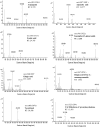Modulatory effects of Terminalia arjuna against domoic acid induced toxicity in Caco-2 cell line
- PMID: 28342004
- PMCID: PMC5507850
- DOI: 10.1007/s10616-017-0080-9
Modulatory effects of Terminalia arjuna against domoic acid induced toxicity in Caco-2 cell line
Abstract
Domoic acid is a potent marine algal toxin produced by diatomic genus of Pseudo-nitzschia causing amnesic shell fish poisoning. Domoic acid toxicosis mainly involves excitotoxic effects coupled with oxidative stress. The present study was aimed to evaluate the protective effects of hydro-alcoholic extract of Terminalia arjuna (TA) against domoic acid induced toxic effects in Caco-2 cell line. It was observed that the toxicity induced by domoic acid in Caco-2 cells was mediated by oxidative insult leading to morphological changes, DNA damage and apoptosis. In our study pre-treatment of the cells with TA (10, 20 and 30 μg/ml) showed significant protection against domoic acid induced morphological, oxidative and apoptotic damages in a dose dependent manner. The effect of phytocompounds present in TA viz., kaempferol and arjungenin showed significant protection against domoic acid induced toxicity in Caco-2 cell line. Hence, it could be inferred that the protective effect of TA extract against domoic acid induced toxicity could be due to the individual or synergistic effects of kaempferol and argungenin. However, further clinical studies are warranted to consider TA as a natural remedy to prevent amnesic shell fish poisoning.
Keywords: Apoptosis; Domoic acid; Morphological changes; Oxidative stress; Phytocompounds; Terminalia arjuna.
Conflict of interest statement
The authors declare that there is no conflict of interest.
Figures








References
LinkOut - more resources
Full Text Sources
Other Literature Sources

